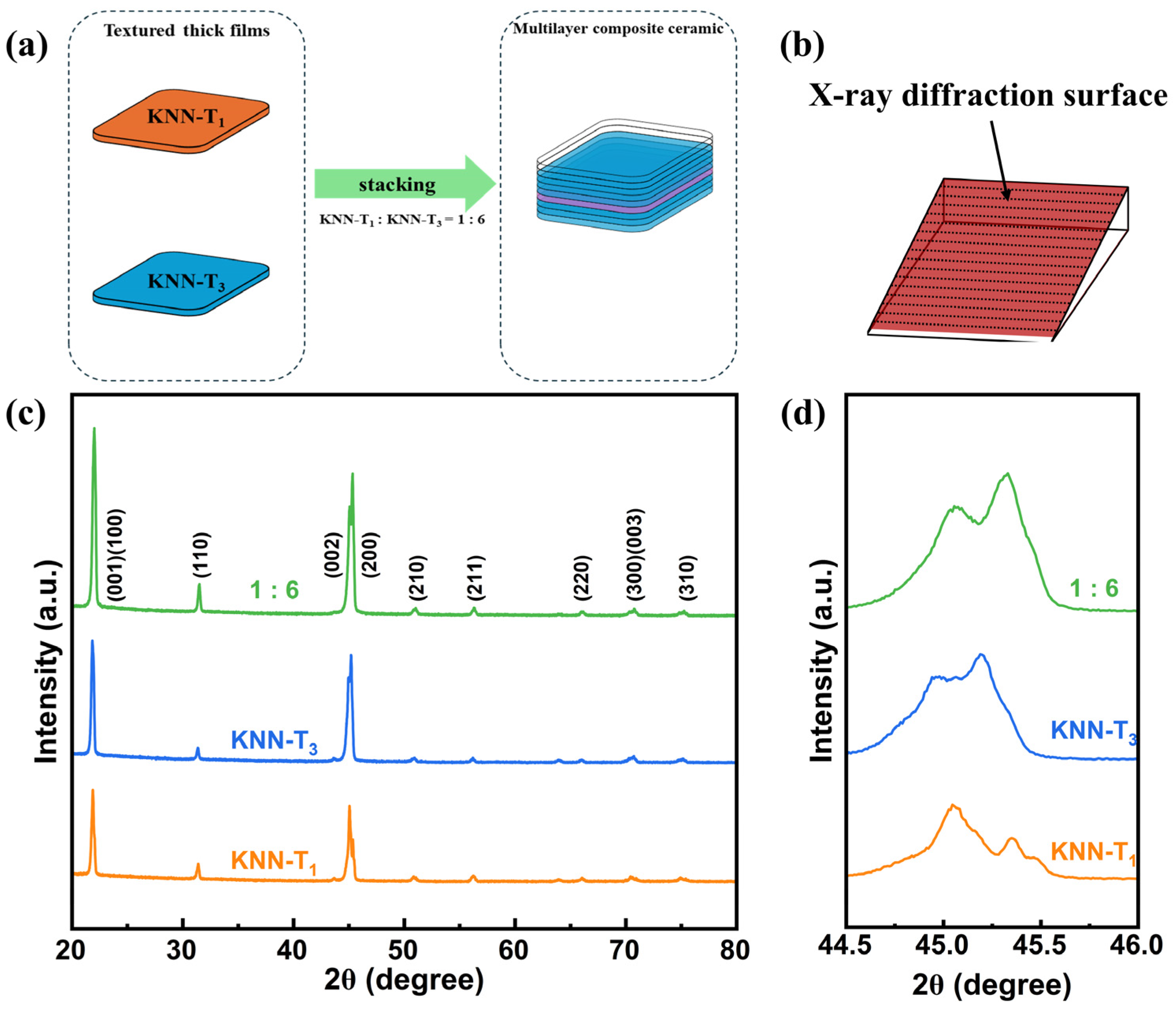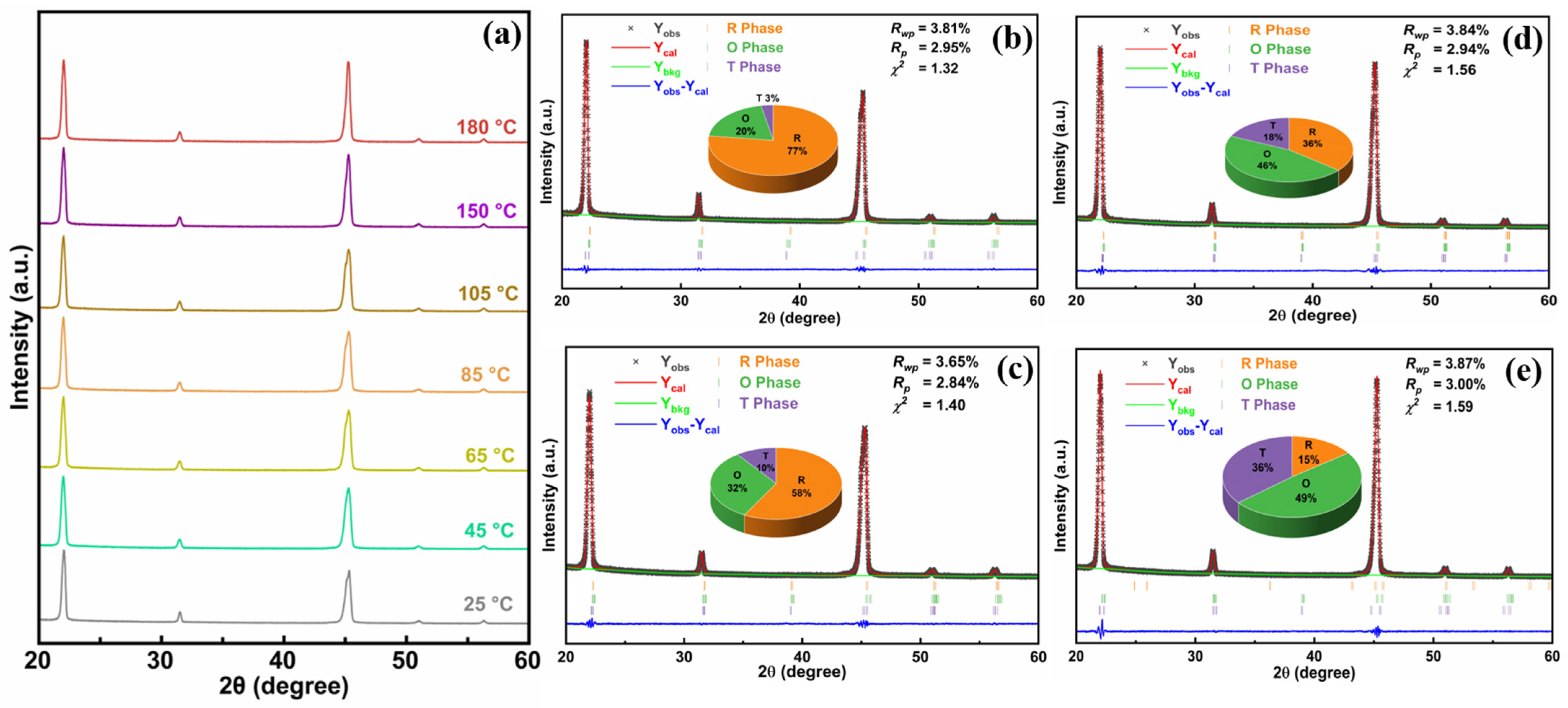High Piezoelectric Performance of KNN-Based Ceramics over a Broad Temperature Range through Crystal Orientation and Multilayer Engineering
Abstract
1. Introduction
2. Results and Discussion
3. Materials and Methods
3.1. Materials and Synthesis
3.2. Characterization
4. Conclusions
Author Contributions
Funding
Institutional Review Board Statement
Informed Consent Statement
Data Availability Statement
Conflicts of Interest
References
- Zheng, T.; Wu, H.; Yuan, Y.; Lv, X.; Li, Q.; Men, T.; Zhao, C.; Xiao, D.; Wu, J.; Wang, K. The structural origin of enhanced piezoelectric performance and stability in lead free ceramics. Energy Environ. Sci. 2017, 10, 528–537. [Google Scholar] [CrossRef]
- Quan, Y.; Ren, W.; Niu, G.; Wang, L.; Zhao, J.; Zhang, N.; Liu, M.; Ye, Z.-G.; Liu, L.; Karaki, T. Large piezoelectric strain with superior thermal stability and excellent fatigue resistance of lead-free potassium sodium niobate-based grain orientation-controlled ceramics. ACS Appl. Mater. Interfaces 2018, 10, 10220–10226. [Google Scholar] [CrossRef] [PubMed]
- Shung, K.K.; Cannata, J.; Zhou, Q. Piezoelectric materials for high frequency medical imaging applications: A review. J. Electroceram. 2007, 19, 141–147. [Google Scholar] [CrossRef]
- Zhang, S.; Li, F. High performance ferroelectric relaxor-PbTiO3 single crystals: Status and perspective. J. Appl. Phys. 2012, 111, 031301. [Google Scholar] [CrossRef]
- Thong, H.C.; Zhao, C.; Zhou, Z.; Wu, C.F.; Liu, Y.X.; Du, Z.Z.; Li, J.F.; Gong, W.; Wang, K. Technology transfer of lead-free (K, Na) NbO3-based piezoelectric ceramics. Mater. Today 2019, 29, 37–48. [Google Scholar] [CrossRef]
- Xue, H.; Zheng, T.; Wu, J. Understanding the nature of temperature stability in potassium sodium niobate based ceramics from structure evolution under external field. ACS Appl. Mater. Interfaces 2020, 12, 32925–32934. [Google Scholar] [CrossRef]
- Rödel, J.; Jo, W.; Seifert, K.T.; Anton, E.M.; Granzow, T.; Damjanovic, D. Perspective on the development of lead-free piezoceramics. J. Am. Ceram. Soc. 2009, 92, 1153–1177. [Google Scholar] [CrossRef]
- Wang, X.; Wu, J.; Xiao, D.; Zhu, J.; Cheng, X.; Zheng, T.; Zhang, B.; Lou, X.; Wang, X. Giant piezoelectricity in potassium–sodium niobate lead-free ceramics. J. Am. Chem. Soc. 2014, 136, 2905–2910. [Google Scholar] [CrossRef]
- Xu, K.; Li, J.; Lv, X.; Wu, J.; Zhang, X.; Xiao, D.; Zhu, J. Superior piezoelectric properties in potassium–sodium niobate lead-free ceramics. Adv. Mater. 2016, 28, 8519–8523. [Google Scholar] [CrossRef]
- Li, P.; Huan, Y.; Yang, W.; Zhu, F.; Li, X.; Zhang, X.; Shen, B.; Zhai, J. High-performance potassium-sodium niobate lead-free piezoelectric ceramics based on polymorphic phase boundary and crystallographic texture. Acta Mater. 2019, 165, 486–495. [Google Scholar] [CrossRef]
- Wang, Y.; Zhu, W.; Sun, Q.; Tan, L. Effects of A/B-site dopants on microstructure and domain configuration of potassium sodium niobate lead-free piezoelectric ceramics. J. Alloy Compd. 2019, 787, 407–413. [Google Scholar] [CrossRef]
- Li, W.; Hao, J.; Fu, P.; Du, J.; Li, P.; Hu, C.; Yue, Z. Large electrostrictive effect and strong photoluminescence properties in Sm2O3-modified lead-free potassium sodium niobate-based piezoelectric ceramics. J. Mater. 2020, 6, 768–780. [Google Scholar] [CrossRef]
- Lv, X.; Zhu, J.; Xiao, D.; Zhang, X.X.; Wu, J. Emerging new phase boundary in potassium sodium-niobate based ceramics. Chem. Soc. Rev. 2020, 49, 671–707. [Google Scholar] [CrossRef] [PubMed]
- Yang, W.; Wang, Y.; Li, P.; Wu, S.; Wang, F.; Shen, B.; Zhai, J. Improving electromechanical properties in KNANS-BNZ ceramics by the synergy between phase structure modification and grain orientation. J. Mater. Chem. C 2020, 8, 6149–6158. [Google Scholar] [CrossRef]
- Gao, J.; Hao, Y.; Ren, S.; Kimoto, T.; Fang, M.; Li, H.; Wang, Y.; Zhong, L.; Li, S.; Ren, X. Large piezoelectricity in Pb-free 0.96(K0.5Na0.5)0.95Li0. 05Nb0. 93Sb0. 07O3-0.04 BaZrO3 ceramic: A perspective from microstructure. J. Appl. Phys. 2015, 117, 084106. [Google Scholar] [CrossRef]
- Gao, J.; Ren, S.; Zhang, L.; Hao, Y.; Fang, M.; Zhang, M.; Dai, Y.; Hu, X.; Wang, D.; Zhong, L. Phase transition sequence in Pb-free 0.96(K0.5Na0.5)0.95Li0.05Nb0.93Sb0.07O3-0.04 BaZrO3 ceramic with large piezoelectric response. Appl. Phys. Lett. 2015, 107, 032902. [Google Scholar] [CrossRef]
- Ming, B.Q.; Wang, J.F.; Qi, P.; Zang, G.Z. Piezoelectric properties of (Li, Sb, Ta) modified (Na, K)NbO3 lead-free ceramics. J. Appl. Phys. 2007, 101, 054103. [Google Scholar] [CrossRef]
- Saito, Y.; Takao, H.; Tani, T.; Nonoyama, T.; Takatori, K.; Homma, T.; Nagaya, T.; Nakamura, M. Lead-free piezoceramics. Nature 2004, 432, 84–87. [Google Scholar] [CrossRef]
- Li, P.; Zhai, J.; Shen, B.; Zhang, S.; Li, X.; Zhu, F.; Zhang, X. Ultrahigh piezoelectric properties in textured (K, Na) NbO3-based lead-free ceramics. Adv. Mater. 2018, 30, 1705171. [Google Scholar] [CrossRef]
- Cheng, Y.; Xing, J.; Li, X.; Xie, L.; Xie, Y.; Tan, Z.; Zhu, J. Meticulously tailoring phase boundary in KNN-based ceramics to enhance piezoelectricity and temperature stability. J. Am. Ceram. Soc. 2022, 105, 5213–5221. [Google Scholar] [CrossRef]
- Zheng, T.; Yu, Y.; Lei, H.; Li, F.; Zhang, S.; Zhu, J.; Wu, J. Compositionally graded KNN-based multilayer composite with excellent piezoelectric temperature stability. Adv. Mater. 2022, 34, 2109175. [Google Scholar] [CrossRef] [PubMed]
- Liu, Q.; Zhang, Y.; Zhao, L.; Gao, J.; Zhou, Z.; Wang, K.; Zhang, X.; Li, L.; Li, J.F. Simultaneous enhancement of piezoelectricity and temperature stability in (K, Na)NbO3-based lead-free piezoceramics by incorporating perovskite zirconates. J. Mater. Chem. C 2018, 6, 10618–10627. [Google Scholar] [CrossRef]
- Song, A.; Liu, Y.; Feng, T.; Li, H.; Zhang, Y.; Wang, X.; Liu, L.; Zhang, B.P.; Li, J.F. Simultaneous enhancement of piezoelectricity and temperature stability in KNN-based lead-free ceramics via layered distribution of dopants. Adv. Funct. Mater. 2022, 32, 2204385. [Google Scholar] [CrossRef]
- Zhang, B.; Wu, J.; Cheng, X.; Wang, X.; Xiao, D.; Zhu, J.; Wang, X.; Lou, X. Lead-free piezoelectrics based on potassium–sodium niobate with giant d33. ACS Appl. Mater. Interfaces 2013, 5, 7718–7725. [Google Scholar] [CrossRef]
- Wang, X.; Wu, J.; Xiao, D.; Cheng, X.; Zheng, T.; Zhang, B.; Lou, X.; Zhu, J. Large d33 in (K, Na)(Nb, Ta, Sb)O3-(Bi, Na, K)ZrO3 lead-free ceramics. J. Mater. Chem. A 2014, 2, 4122–4126. [Google Scholar] [CrossRef]
- Rubio-Marcos, F.; Lopez-Juarez, R.; Rojas-Hernandez, R.E.; del Campo, A.; Razo-Perez, N.; Fernandez, J.F. Lead-free piezoceramics: Revealing the role of the rhombohedral–tetragonal phase coexistence in enhancement of the piezoelectric properties. ACS Appl. Mater. Interfaces 2015, 7, 23080–23088. [Google Scholar] [CrossRef]
- Yao, W.; Zhang, J.; Zhou, C.; Liu, D.; Su, W. Giant piezoelectricity, rhombohedral-orthorhombic-tetragonal phase coexistence and domain configurations of (K, Na)(Nb, Sb)O3–BiFeO3-(Bi, Na)ZrO3 ceramics. J. Eur. Ceram. Soc. 2020, 40, 1223–1231. [Google Scholar] [CrossRef]
- Wang, K.; Li, J.F. Analysis of crystallographic evolution in (Na, K)NbO3-based lead-free piezoceramics by X-ray diffraction. Appl. Phys. Lett. 2007, 91, 262902. [Google Scholar] [CrossRef]
- Yao, F.Z.; Wang, K.; Jo, W.; Webber, K.G.; Comyn, T.P.; Ding, J.X.; Xu, B.; Cheng, L.Q.; Zheng, M.P.; Hou, Y.D. Diffused phase transition boosts thermal stability of high-performance lead-free piezoelectrics. Adv. Funct. Mater. 2016, 26, 1217–1224. [Google Scholar] [CrossRef]
- Liu, Y.X.; Thong, H.C.; Cheng, Y.Y.S.; Li, J.W.; Wang, K. Defect-mediated domain-wall motion and enhanced electric-field-induced strain in hot-pressed K0.5Na0.5NbO3 lead-free piezoelectric ceramics. J. Appl. Phys. 2021, 129, 024102. [Google Scholar] [CrossRef]
- Dai, Y.; Zhang, X.; Zhou, G. Phase transitional behavior in K0.5Na0.5NbO3–LiTaO3 ceramics. Appl. Phys. Lett. 2007, 90, 262903. [Google Scholar] [CrossRef]
- Cen, Z.; Huan, Y.; Feng, W.; Yu, Y.; Zhao, P.; Chen, L.; Zhu, C.; Li, L.; Wang, X. A high temperature stable piezoelectric strain of KNN-based ceramics. J. Mater. Chem. A 2018, 6, 19967–19973. [Google Scholar] [CrossRef]
- Liu, Q.; Zhang, Y.; Gao, J.; Zhou, Z.; Wang, H.; Wang, K.; Zhang, X.; Li, L.; Li, J.F. High-performance lead-free piezoelectrics with local structural heterogeneity. Energy Environ. Sci. 2018, 11, 3531–3539. [Google Scholar] [CrossRef]
- Go, S.H.; Kim, H.; Kim, D.S.; Eum, J.M.; Chae, S.J.; Kim, E.J.; Nahm, S. Improvement of piezoelectricity of (Na, K)Nb-based lead-free piezoceramics using [001]-texturing for piezoelectric energy harvesters and actuators. J. Eur. Ceram. Soc. 2022, 42, 6478–6492. [Google Scholar] [CrossRef]
- Li, P.; Gao, S.; Lu, G.; Zhao, Y.; Hao, J.; Fu, P.; Du, J.; Bai, W.; Li, W.; Zhai, J. Significantly enhanced piezoelectric temperature stability of KNN-based ceramics through multilayer textured thick films composite. J. Eur. Ceram. Soc. 2024, 44, 3861–3868. [Google Scholar] [CrossRef]
- Gao, S.; Li, P.; Qu, J.; Li, W.; Zhai, J.; Wang, F.; Hao, J.; Fu, P.; Pan, Z.; Bai, W. Crystallographic texture and phase structure induced excellent piezoelectric performance in KNN-based ceramics. J. Am. Ceram. Soc. 2023, 106, 3481–3490. [Google Scholar] [CrossRef]
- Li, F.; Lin, D.; Chen, Z.; Cheng, Z.; Wang, J.; Li, C.; Xu, Z.; Huang, Q.; Liao, X.; Chen, L.-Q. Ultrahigh piezoelectricity in ferroelectric ceramics by design. Nat. Mater. 2018, 17, 349–354. [Google Scholar] [CrossRef]
- Xue, H.; Zheng, T.; Wu, J. Insights into the correlation between tetragonal phase and temperature stability of potassium sodium niobate based ceramics from domain behaviors. Adv. Electron. Mater. 2022, 8, 2100257. [Google Scholar] [CrossRef]
- Zheng, T.; Zhang, Y.; Ke, Q.; Wu, H.; Heng, L.W.; Xiao, D.; Zhu, J.; Pennycook, S.J.; Yao, K.; Wu, J. High-performance potassium sodium niobate piezoceramics for ultrasonic transducer. Nano Energy 2020, 70, 104559. [Google Scholar] [CrossRef]
- Li, P.; Fu, Z.; Wang, F.; Huan, Y.; Zhou, Z.; Zhai, J.; Shen, B.; Zhang, S. High piezoelectricity and stable output in BaHfO3 and (Bi0.5Na0.5)ZrO3 modified (K0.5Na0.5)(Nb0.96Sb0.04)O3 textured ceramics. Acta Mater. 2020, 199, 542–550. [Google Scholar] [CrossRef]
- Zhou, J.S.; Wang, K.; Yao, F.Z.; Zheng, T.; Wu, J.; Xiao, D.; Zhu, J.; Li, J.F. Multi-scale thermal stability of niobate-based lead-free piezoceramics with large piezoelectricity. J. Mater. Chem. C 2015, 3, 8780–8787. [Google Scholar] [CrossRef]
- Wang, R.; Wang, K.; Yao, F.; Li, J.F.; Schader, F.H.; Webber, K.G.; Jo, W.; Rödel, J. Temperature stability of lead-free niobate piezoceramics with engineered morphotropic phase boundary. J. Am. Ceram. Soc. 2015, 98, 2177–2182. [Google Scholar] [CrossRef]
- Wu, B.; Ma, J.; Gou, Q.; Wu, W.; Chen, M. Enhanced temperature stability in the O–T phase boundary of (K, Na) NbO3-based ceramics. J. Am. Ceram. Soc. 2020, 103, 1698–1708. [Google Scholar] [CrossRef]
- Wang, D.; Fotinich, Y.; Carman, G.P. Influence of temperature on the electromechanical and fatigue behavior of piezoelectric ceramics. J. Appl. Phys. 1998, 83, 5342–5350. [Google Scholar] [CrossRef]
- Zhao, C.; Yin, J.; Huang, Y.; Wu, J. Polymorphic characteristics challenging electrical properties in lead-free piezoceramics. Dalton Trans. 2019, 48, 11250–11258. [Google Scholar] [CrossRef]
- Lv, X.; Wu, J.; Zhang, X.-X. A new concept to enhance piezoelectricity and temperature stability in KNN ceramics. Chem. Eng. J. 2020, 402, 126215. [Google Scholar] [CrossRef]
- Wu, B.; Ma, J.; Wu, W.; Chen, M. Improved piezoelectricity in ternary potassium–sodium niobate lead-free ceramics with large strain. J. Mater. Chem. C 2020, 8, 2838–2846. [Google Scholar] [CrossRef]






Disclaimer/Publisher’s Note: The statements, opinions and data contained in all publications are solely those of the individual author(s) and contributor(s) and not of MDPI and/or the editor(s). MDPI and/or the editor(s) disclaim responsibility for any injury to people or property resulting from any ideas, methods, instructions or products referred to in the content. |
© 2024 by the authors. Licensee MDPI, Basel, Switzerland. This article is an open access article distributed under the terms and conditions of the Creative Commons Attribution (CC BY) license (https://creativecommons.org/licenses/by/4.0/).
Share and Cite
Lu, G.; Li, Y.; Zhao, R.; Zhao, Y.; Zhao, J.; Bai, W.; Zhai, J.; Li, P. High Piezoelectric Performance of KNN-Based Ceramics over a Broad Temperature Range through Crystal Orientation and Multilayer Engineering. Molecules 2024, 29, 4601. https://doi.org/10.3390/molecules29194601
Lu G, Li Y, Zhao R, Zhao Y, Zhao J, Bai W, Zhai J, Li P. High Piezoelectric Performance of KNN-Based Ceramics over a Broad Temperature Range through Crystal Orientation and Multilayer Engineering. Molecules. 2024; 29(19):4601. https://doi.org/10.3390/molecules29194601
Chicago/Turabian StyleLu, Guangrui, Yunting Li, Rui Zhao, Yan Zhao, Jiaqi Zhao, Wangfeng Bai, Jiwei Zhai, and Peng Li. 2024. "High Piezoelectric Performance of KNN-Based Ceramics over a Broad Temperature Range through Crystal Orientation and Multilayer Engineering" Molecules 29, no. 19: 4601. https://doi.org/10.3390/molecules29194601
APA StyleLu, G., Li, Y., Zhao, R., Zhao, Y., Zhao, J., Bai, W., Zhai, J., & Li, P. (2024). High Piezoelectric Performance of KNN-Based Ceramics over a Broad Temperature Range through Crystal Orientation and Multilayer Engineering. Molecules, 29(19), 4601. https://doi.org/10.3390/molecules29194601





